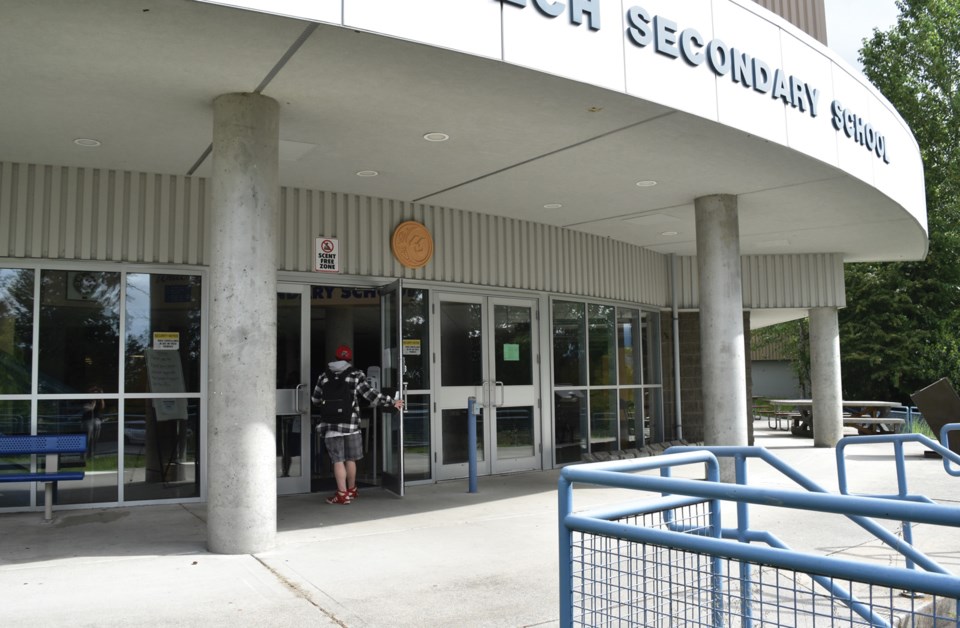Plans are underway for part-time, voluntary in-class instruction but scheduling and transportation will depend on how many students actually return to school the week of June 1.
Students in kindergarten to Grade 5 will likely have two full days of in-class instruction per week, School District No. 46 (SD46) superintendent Patrick Bocking said Tuesday.
If more return, then classes will be divided in half to maintain physical distance between students. That would mean one group of students would attend school for two days a week and a second group would attend on two separate days.
Four days of classes per week would leave only one day of instruction for at-home learners. “Teachers would frontload them with things they can do during that week and then reconnect with them once a week,” explained Bocking.
Students from Grade 6 to 12 are expected to attend school once a week, while children of essential service workers can continue attending school full time.
In all cases, online and in-school instruction will remain separate. “We’re not going to be live-streaming from the classroom,” Bocking said.
And more emphasis will be placed on in-school instruction. “Teachers are going to be busy teaching in class. They will have some time to support students at home as well, and they will continue to do that even though the delivery time will be less,” Bocking said.
School districts must get approval from the Ministry of Education for their return to school and safety plans and they are required to contact parents by May 22. Parents at SD46 will be asked to fill out a survey so administrators know how many children to expect.
Parents’ responses to the return have been mixed, said Bocking, adding it’s “perfectly reasonable” for some parents to keep their kids at home, given that’s been the advice for the past two months.
“That’s why the gentle turn is so important,” he said. “We feel strongly that with the right protocols in place that we can open up our schools safely.”
Workloads and PPE
While Sunshine Coast Teachers’ Association (SCTA) president Jacquie Shelemey said they have been working collaboratively with the school district, the union raised concerns about access to personal protective equipment (PPE) and a potentially demanding schedule for staff.
She said the union opposes the government’s “refusal to provide PPE to those teachers who request it.” Currently, only staff who meet WorkSafeBC requirements will be provided with a mask.
“Teachers who feel the need for PPE to be safe in their workplace should have it provided by their employer, and the union, both provincially and locally, will continue to push for the employer to provide PPE upon request.”
Bocking said the district will follow the WorkSafeBC guidelines around PPE. “Based on medical evidence and the advice from our public health officer, PPE is not needed for educational staff,” he said, but the district supports staff and students who wish to wear their own.
He said the district does have an adequate supply for the staff who do require face masks and other protective gear.
Workload was also flagged by Shelemey.
“Teachers are very concerned that the addition of days in school alongside providing remote learning opportunities will create an unmanageable workload and the union is equally as concerned.”
She said the union will be “working closely” with the SD46 management team “to create a plan that considers teacher workload in its implementation.”
Bocking said he does not expect teaching staff to take on extra hours as they take on both forms of teaching. Instead, in-class learning will take the majority of teachers’ time.
“We do have to adjust the expectations and the understanding of what is happening for remote learning,” he said. Administrative staff will have to work with teachers and “give them licence to adjust their work patterns.”
Transportation
As with facilities, the province has created school bus safety guidelines, including separating students to maintain physical distancing. Because of the reduced capacity, parents are being asked to find other means of transportation.
“We will encourage people who are coming to consider alternative ways to come to school if they are able to do that,” Bocking told Coast Reporter.
Because it’s unclear how many students will actually need the bus, it’s also unclear how routes and scheduling will look, according to Thirdwave Bus Services manager Randy Gould.
“We’re waiting to see what sort of volume of kids is [expected].”
As for staffing levels, Gould said that, too, is up in the air. “We’re not pushing anybody to do it, that’s for sure.”
Buses will be disinfected according to BCCDC guidelines and it’s also recommended that a Plexiglas barrier be installed between passengers and the drivers, and for students to be separated.
The survey is expected to be released this week at sd46.bc.ca.
– With files from Chuck Chiang, Business in Vancouver



